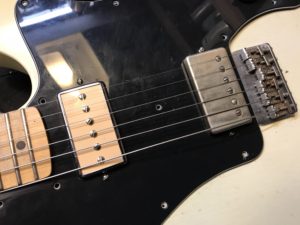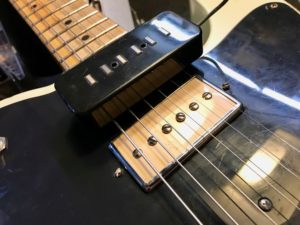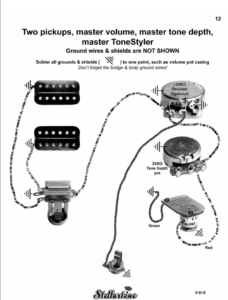Fender’s Telecaster Deluxe has had an interesting and checkered history. Once regarded as yet another mediocre product from the company’s era of CBS ownership, these turn-of-the-seventies instruments now fetch huge prices on the collector’s market. I’ve never owned own. But when singer/songwriter Greer Sinclair loaned me one of Fender’s 2010 reissues, it was time for research — and experimentation.
The made-in-Mexico 1972 Deluxe reissue is a cool guitar. It replicates many details of the original: the oversized headstock, the Strat-like belly cut and fixed Strat-style bridge, and the big-ass pickguard. But its pickups are definitely a departure. In lieu of the original’s large-format “Wide Range” pickups, it employs a P-94R (a humbucker-sized P-90 spinoff) at the neck, and a conventional Gibson-style humbucker at the bridge.
The Wide Range pickup was a unique beast. Fender had commissioned Seth Lover, the man who invented the Gibson humbucker, to create a Fender humbucker in hopes of cashing in on the growing popularity of hard rock. With DC resistance in the 10k range, the new Wide Range pickup was a bit hotter than a vintage Gibson humbucker. Wide Range pickups appeared in several of the era’s models, including the Tele Thinline, Tele Custom, and semi-hollowbody Starcaster.
Gibson humbuckers have a bar magnet within, but the pole pieces are not magnetic. But on Wide Range pickups, the pole pieces are magnetic, as on Fender’s single-coil pickups. Situating individual magnets closer to the strings yield a brighter sound with greater note defition and string-to-string separation — characteristics we associate with vintage Fender pickups. So the Wide Range pickup lent a uniquely “Fender” twist to the Gibson design.

Wide Range pickups are slightly larger than conventional humbuckers. Most of Fender’s circa-1970 Tele reissues substitute generic humbuckers of the standard size. Standard humbuckers can sound superb in a Tele, but they’re horses of different colors. Fender has also created some reissues with the larger-sized pickups, but these are also garden-variety humbuckers — the larger format is purely cosmetic. The pole pieces of the factory humbucker on Greer’s guitar don’t align with Fender’s wider string spacing. (But one thing I’ve leaned from my various Fender/Gibson hybrid experiments is that sonically, this can matter very little.)
The P-94R’s cream-colored top looks wicked against the guitar’s finish. It’s a warm, full-sounding pickup from the mellower side of the P-90 spectrum. Actually, it doesn’t sound all the different from a traditional Telecaster neck pickup. (Like that pickup, it works quite well for jazz.) Note, though, that its dimensions differs substantially from those of a Gibson P-90, as you can the in the photo where it sits alongside a historically accurate Lollar P-90. When you change the size of a pickup’s components, you inevitably alter the sound. The tones can be for better or worse — but they will be different.

Before moving on to a pair of Regals, Jason Lollar’s ultra-authentic Wide Range replicas, I popped in a set of Lollar’s humbucker-sized Charlie Christian pickups. This is the same model I used for my “Are Charlie Christian Pickups Only For Jazz?” post and video. These are some of the lowest-output pickups you can buy today, yet they have a nice, full sound. They often have a rough-edged quality, like a more extreme version of a vintage P-90. Despite their swing-era associations, they sound kller distortion. (Danny Gatton used a CC pickup in his Tele’s neck position, but I dig them at the bridge position too.)
To install the larger-format Lollar pickups, I need to order a new pickguard from Pickguard Heaven. (Fun fact: The company is run by Paul and Adrienne Chandler, who made some very cool guitars and pedals in the ’80s and ’90s when they ran Chandler Industries.) While swapping pickups and pickguards, I redid all the guitar’s wiring. Tele Deluxes are wired like Les Pauls with an individual volume and tone control per pickup. I usually replace these with master volume and tone controls. With Les Paul-style wiring, lowering the volume of one pickup while in the combined position always feels underwhelming to me. There’s a tiny bit of variation at the top end of the volume pots, but below that, one pickup predominates entirely. (The A500K pot taper works fine as a volume control, but it sucks as a blend pot.) Likewise, dialing in contrasting tone settings in the combined pickup position never does much for me. I’d rather use the freed-up control positions for something different.

I installed a Stellartone ToneStyler as the master tone control. (There’s lots of info about this part on this site — just search.) While I would have loved to add onboard distortion, I cringe at the thought of removing that mondo pickguard for battery changes. Instead, I added a bass-cut tone control as in the G&L “PTB” wiring scheme. And for the final control, I borrowed an idea from the Stellartone site: a 25K blend pot upstream from the ToneStyler.
See, on a traditional tone pot, the cap value determines the cutoff frequency. The tone pot shunts signal to ground, varying the amount of treble cut as that specific frequency. But ToneStylers aren’t pots — they’re switches. The part houses a set of capacitors of escalating size. Changing switch positions changes the cap/cutoff frequency, not the depth of the cut. To my ear, this substitution adds power and interesting resonance to the treble-cut settings. Here, though, the blend pot is a depth control, so you have both selectable cutoff frequency and adjustable cutoff depth. Is it a worthily mod? I’m not sure yet. I need to get used to it.
Thanks again, Greer, for loaning me this cool instrument!








Hi Joe – great video and timely, I also am starting a WRHB build (Telenator T3 set, half cunife threaded pole pieces half alnico slugs). If I send them to you could you wire the tonestyler/bass cut/depth 25k and 1000mg master as you did with the Lollars? I’ll compensate you for the parts and time, and you could do a comparison video with the setup for a part two video?
Signed/pain-in-the-a$$ fan#1
Trust me, Mike — you don’t want me working on your guitar. I have a good ear and a creative mind, I think, but my craft skills are terrible. On the other hand, any good guitar tech should be able to do this wiring for you if you provide the schematics. All this stuff is in a Premier Guitar article from a few years ago: https://www.premierguitar.com/articles/21112-three-must-try-guitar-wiring-mods?page=3
…While i was typing that it seemed like a great idea – then i hit send and thought “wait Joe seems a pretty busy guy and I’m fairly certain he doesn’t make ends meet as Joe the guitar tech for random guitar nerds”. Thanks for the reply, I appreciate all your videos, seriously you were one of the reasons i starting picking up the guitar after a long hiatus (alongside discovering sonic youth and My bloody valentine and wanting to learn how to do what they do). You’re doing God’s work in a vast wasteland of unwanted modern guitar wankery. Keep it up and can’t wait to see what you’ve got coming next.
Oh no — I’m flattered you asked. I’m not just being though, or making an excuse not to help out. I’m a clever slob at the workbench, but a slob nonetheless. 🙂
hey joe i was wondering about your switchable booster buffer pedal i want to add a led to know when i’m on the buffer circuit but don’t know where to connect it can you help me out
It you have a battery but no DC jack, refer to this:
https://www.generalguitargadgets.com/pdf/ggg_sw_3pdt_tb_bat.pdf
If you have a DC jack, check out this variation:
https://www.generalguitargadgets.com/pdf/ggg_sw_3pdt_tb_gi_dcj.pdf
Hope that helps!
Thanks Joe! I ‘m using the above wiring but I would like to put a your cult boost in place of the 25k depth, could you point me to instructions on how you’ve installed it in the past? Do I need to buy the pedal then gut it? Thanks you !
Really enjoyed listening to your vid through good headphones–just the sort of info/experience I crave for my own imaginatings with regard to my own guitars, especially my standard-style Tele, which is cringing over in the corner even as I write this. For starters, I have a Tom Anderson neck-position humbucker that I’m thinking of installing. Routing, new pickguard, new electronics! This won’t hurt a bit…
Thanks for the kind words, Blake. I’m glad you found it in formative. I’ve never tried that pickup — let me know how the project turns out!
The Tele turned out really well. It now has an Anderson H1 neck-position humbucker and an Anderson TV3 (single-coil) in the bridge position. Tom Anderson himself was kind-enough to recommend the TV3 as a good match for the H1, and he went on to advise me to use 500-k pots, but to switch in a 330-k resistor to ground when both pickups are engaged. Works a treat!
I also added a coil-split switch to run the H1 as single-coil, and it has a very nice, bell-like clarity to it is when engaged.
An interesting (to me, at least) detail: I set up the coil-splitting per Anderson’s instructions, i.e., to short the unused coil to ground. However, on my previous project (Carvin kit guitar with Lollar Imperial HBs), I connected the coil-split switch to switch between the “both coils” point and the coil-tap point, thus leaving the “both coils” point floating when switched to single-coil mode. In this scheme, neither of the coils gets shorted. I’m thinking of going back into the Carvin and re-doing the switching so that a coil is shorted for single-coil mode, just to see if I can hear a difference.
Another detail: the Tele needed fret-leveling and re-crowning. The guy I usually go to was apparently too busy for me, so I spent the money I would’ve paid him on tools from StewMac, and managed to do the job myself… whew! Great learning experience all around.
Oh, cool! Sounds killer.
I recently went a little crazy and bought a 2017 Limited Edition American Professional Mahogany Tele Deluxe ShawBucker. This may well be the guitar of my dreams. It is constructed of wood from a mahogany tree brought down by a hurricane 20 years ago. It is all mahogany including the neck. The pickups are tricked out Shawbuckers with offset poles. He used different alnico types on the two sets of poles which gives it a bit more sparkle. It also has treble bypass on the volume controls. It is truly a Fender/Gibson hybrid sound wise. I usually try to keep my guitar purchases under $1000 but my heart beat my head like a dead mule.
As to the original Fender wide range pickup there is an article on Reverb’s blog with an unpublished interview with Seth Lover:
https://reverb.com/news/interview-seth-lover-on-inventing-the-paf-humbucker-and-why-he-left-gibson-for-fender-bacons-archive
Thank You so much mwseniff!
The link You provided (with all the links embedded there) made my week to work and back home this week.
Such a journey into electric/acoustic innovation sagas.
Reverb.com sitei seems to be so much more than just an online marketplace.
This tonefiend.com realm seems to be a real treasure for anyone interested in modern/vintage amplified stringed musical instruments.
Joe, keep on blogging!
If your into building your own guitars Guitar Fetish has great deals on bodies and necks. They also have a bunch of set neck guitars with no hardware. They have tele and strat set necks as well as LP style. They are also pretty cheap.I have a set neck teles both as a traditional type as well as the two humbucker tele pro style. Great units I have built guitars with them including several I converted to fretless. They play like a dream.
A big part of the Fender wide range humbucker sound has to be the vertical rod magnets in the centre of the coils. I kinda wonder why, when CuNiFe rods were hard to find, Fender didn’t ever come out with a version of the wide range with fixed staggered (or even flat) Alnico rod magnets, rather than just wimping out with P90s and a standard humbucker in a big case.
Good question. I suspect the Occam’s Razor solution is that a) the material was expensive and b) potential customers din’t know or care enough to mind a generic humbucker. Hey, Strats and Teles can sound killer with PAFs and P-90s. But man, the Wide Range design sure sounds different., I haven’t gotten around to it yet, but I’m going to post an update to this video. I wound up reinstalling the Lollar Wide Range, doing as lot of setup on the guitar (including springing for a Plek job) tinkering with the tone controls, and installing a Cult distortion circuit. It’s pretty bitchin’ …
According to the interview with Seth Lover (url above),he used CuNiFe because they could be machined into threaded rods making them individually adjustable. Alnico is brittle and would have required a separate elevator system for each pole. He actually shows a prototype of a pickup like that, which nobody was interested in making them. Very interesting interview, things people have been agonizing over for years were mere whims. The orientation of the screws on PAFs in Gibsons was based on appearance not performance. All heroes have feet of clay.
I did not know that! Thanks for the info. 🙂
Yup I did know about the CuNiFe and that it is not now a commonly used material and probably wasn’t when Mr Lover designed the first wide range pickups. I would guess that Fender had the CuNiFe rods made to special order. He says he used the vertical arrangement of CuNiFe rod magnets to flavor the pickups with some of the Fender bite and brightness, but I suspect it may also have been to get around the Gibson humbucker patent. He would after all, as the designer of the Gibson pickups, have been in hot water if he had infringed the patent. And there were the Ray Butts designed Gretsch Filtertrons (which reached the market before the Gibson humbuckers) to worry about too.
My speculation was over why Fender did not use fixed Alnico rods on the wide range reissues. CuNiFe was out of the question as it would certainly been too expensive and I suppose the relative cost of one flat bar Alnico magnet might have been cheaper than twelve Alnico rods in place of the CuNiFe.
I’m not sure what you meant Matt by heroes with clay feet. According to Mr Lover he never intended the Gibson humbuckers to have adjustable poles and he told management they just were not necessary. The adjustable poles were added because the marketing guys insisted the new pickup had to not only be better than the preceding P90, but also needed to have adjustable poles because they were a sales feature they emphasized on the P90. Lover says that never argued too much over details because he just wanted to keep those paychecks coming.
In the interview he does comment that the visible poles on the neck pickup were oriented to the neck and on the bridge pickup to the bridge. At that point the whole poles issue didn’t matter to him, he just wanted to keep his bosses happy.
He does seem to have had a strong sense of his worth and shortly after left Gibson for a higher paid job.
We tend to take folk like Seth Lover and figure everything he did was inspired genius. The fact is he made choices not based on creating the ultimate tone but based upon appearance or other non-musical reasons. My point is we tend to make them into demi-gods when they are no different than you.and me. It is an unfortunate tendency because we then muss important things. Heck I’m an old guy I’ve seen too much to believe otherwise, and I was always a cynic.
My friend just observed that frets 9-12 have way less wear than all the other frets. Is that a meaningless artifact, or the result of something interesting?
[…] countless hours transcribing classic Telecaster riffs, I’ve developed a deep appreciation for single pickup Tele variants. These streamlined instruments offer a unique playing experience that sets them apart from their […]
Hey Joe, great demo and write up! Love it. Glad i found your page, you’ve got a lot of really interesting stuff.
Hi Jack! Wow, thanks for the kind words. And delighted that you find my stuff useful and interesting. 🙂